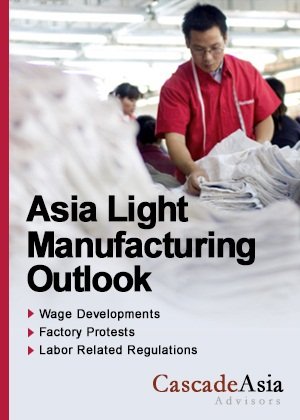Outlook on Light Manufacturing in China: March 2015
The below is a sample of Cascade Asia Advisor’s monthly report on light manufacturing across emerging Asia, available for purchase through the Asia Briefing bookstore. The report is a 4-5 page executive-ready assessment and outlook designed to help companies anticipate labor risks and dynamics across key manufacturing countries in Asia. Countries of coverage include Cambodia, China, Indonesia and Vietnam.
China
 Early March will see the largest wave of workers returning from Chinese New Year (CNY) celebrations, however, most factories in coastal areas will struggle to sustain their workforce. A recent survey shows the majority of factories would be willing to increase wages by 5% to 10% to retain their workers and to recruit new ones to replace those not returning. Some may also face higher labor costs with the distribution of promised annual bonuses and the reimbursements of workers’ return transportation costs.
Early March will see the largest wave of workers returning from Chinese New Year (CNY) celebrations, however, most factories in coastal areas will struggle to sustain their workforce. A recent survey shows the majority of factories would be willing to increase wages by 5% to 10% to retain their workers and to recruit new ones to replace those not returning. Some may also face higher labor costs with the distribution of promised annual bonuses and the reimbursements of workers’ return transportation costs.
Factories will pay less for their employees’ unemployment insurance under the central government’s recent decision to reduce the combined contribution of employers and employees from 3% of an employee’s monthly wage to 2%. The actual percentage from each party will be determined at the provincial level.
Guangdong: Beginning March 1, Shenzhen’s minimum wage increased to 2,030 yuan per month followed by a province-wide average increase of 19% effective from May 1. The provincial labor bureau estimates 92% of migrant workers will return to Guangdong after CNY, leading to a deficit of 600,000 to 800,000 laborers from pre-CNY levels.
Fujian: The provincial government is adopting a pilot household registration (hu-kou) reform initiative to help retain its workforce and simplify housing management. Migrant workers in Quanzhou and a handful of other cities in the province will be able to register their families as local residents with legally approved leases and labor contracts. Execution details and dates are to be determined.
Zhejiang: Local governments are intensifying efforts to adopt the ‘Machines Replace People’ program which aims to increase productivity and reduce dependence on low-skilled manpower through technological upgrades. Compared to their counterparts in the Pearl River Delta, factories in Zhejiang may therefore be less impacted by the post-CNY labor shortages.
|
Cascade Asia Advisors is a boutique advisory firm focused on Southeast Asia. They help businesses anticipate risk and make better decisions using forward-looking, localized intelligence. For information about developments mentioned in this report, please contact them at info@cascadeasia.com. Asia Briefing Ltd. is a subsidiary of Dezan Shira & Associates. Dezan Shira is a specialist foreign direct investment practice, providing corporate establishment, business advisory, tax advisory and compliance, accounting, payroll, due diligence and financial review services to multinationals investing in China, Hong Kong, India, Vietnam, Singapore and the rest of ASEAN. For further information, please email china@dezshira.com or visit www.dezshira.com. Stay up to date with the latest business and investment trends in Asia by subscribing to our complimentary update service featuring news, commentary and regulatory insight. |
![]()
 Manufacturing Hubs Across Emerging Asia
Manufacturing Hubs Across Emerging Asia
In this issue of Asia Briefing Magazine, we explore several of the region’s most competitive and promising manufacturing locales including India, Indonesia, Malaysia, Singapore, Thailand and Vietnam. Exploring a wide variety of factors such as key industries, investment regulations, and labor, shipping, and operational costs, we delineate the cost competitiveness and ease of investment in each while highlighting Indonesia, Vietnam and India’s exceptional potential as the manufacturing leaders of the future.
 The Asia Sourcing Guide 2015
The Asia Sourcing Guide 2015
In this issue of Asia Briefing, we explain how and why the Asian sourcing market is changing, compare wage overheads, and look at where certain types of products are being manufactured and exported. We discuss the impact of ASEAN’s Free Trade Agreements with China and India, and highlight the options available for establishing a sourcing model in three locations: Vietnam, China, and India. Finally, we examines the differences in quality control in each of these markets.
 Adapting Your China WFOE to Service China’s Consumers
Adapting Your China WFOE to Service China’s Consumers
In this issue of China Briefing Magazine, we look at the challenges posed to manufacturers amidst China’s rising labor costs and stricter environmental regulations. Manufacturing WFOEs in China should adapt by expanding their business scope to include distribution and determine suitable supply chain solutions. In this regard, we will take a look at the opportunities in China’s domestic consumer market and forecast the sectors that are set to boom in the coming years.
- Previous Article Investing in China’s Entertainment Industry
- Next Article China and Asia’s Free Trade Corridors and Beneficial Tax Agreements



























